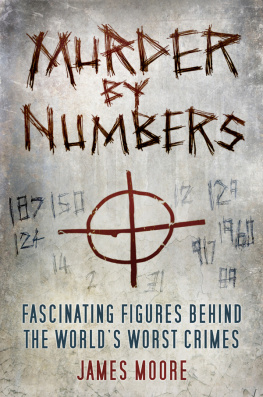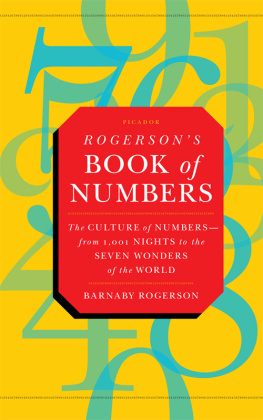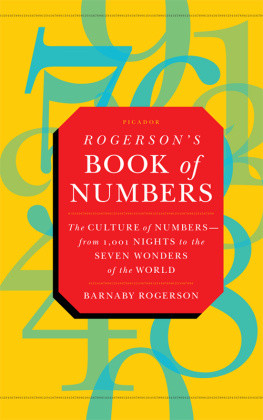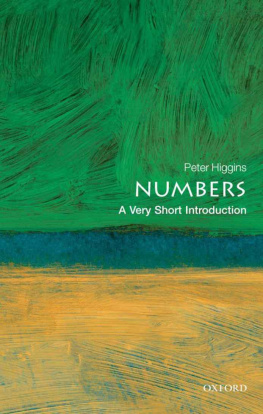NUMBER WORDS
AND NUMBER SYMBOLS
A C ULTURAL H ISTORY OF N UMBERS
Karl Menninger
Translated by Paul Broneer
from the revised German edition
DOVER PUBLICATIONS, INC., N EW Y ORK
Tolle numerum omnibus rebus
et omnia pereunt .
Take from all things their number,
and all shall perish.
I SIDORE OF S EVILLE ( CA . 600)
Translated from the German with permission of the Vandenhoeck & Ruprecht Publishing Company, Gttingen, Germany.
English translation copyright 1969 by The Massachusetts Institute of Technology.
All rights reserved.
This Dover edition, first published in 1992, is an unabridged, unaltered republication of the English translation (published by The MIT Press, Cambridge, Mass., 1969) of the revised German edition of Zahlwort und Ziffer: Eine Kulturgeschichte der Zahlen , published by the Vandenhoeck & Ruprecht Publishing Company, Gttingen, Germany, 195758.
The Dover edition is published by special arrangement with Vandenhoeck & Ruprecht GmbH & Co. KG, Theaterstrasse 13, Postfach 3753, D-3400 Gttingen, Germany, and with The MIT Press, Massachusetts Institute of Technology, 55 Hayward Street, Cambridge, Massachusetts 02142.
Library of Congress Cataloging-in-Publication Data
Menninger. Karl, 1898
[Zahlwort und Ziffer. English]
Number words and number symbols : a cultural history of numbers / Karl Menninger ; translated by Paul Broneer from the revised German edition.
p. cm.
Translation of: Zahlwort und Ziffer.
Originally published: Cambridge, Mass.: M. I. T. Press, 1969.
Includes index.
ISBN 0-486-27096-3 (pbk.)
1. NumeralsHistory. 2. NumerationHistory. 3. AbacusHistory. I. Title.
QA141.2.M4513 1992
513.5dc20
91-42709
CIP
Manufactured in the United States by Courier Corporation
27096304
www.doverpublications.com
The concept of number exerts a dual enchantment. When it uncovers the rich relationships between pure magnitudes to the scientist, it fills him with the satisfaction of intellectual insight; for the sake of these relationships the sovereign structure of mathematics rests upon the concept of number. For others it exerts a fascination by its deep interconnection with the daily life of the people. Is it not true that every tribe spoke and noted down numbers, that every tribe had to calculate whenever it faced life on this planet? Did mans relationship to his environment not also necessitate his relationship with numbers?
This book tries to trace this interweaving of numbers and human life. It strives to demonstrate how the clear concept of number adopts a multiple image when it grows with a people. Together the history of knowledge and of culture create a single picture: the first establishes the boundaries, the second fills the spaces with color. And all along the wealth of detail, no matter how much it takes up the readers attention, permits the music to be heard of the eternal stream at whose banks the fate of humanity is fulfilled.
Number takes shape both in spoken and in written language, in number word and number symbol. Just as a child learns to count one, two, three long before it learns to write or calculate with the numerals 1, 2, 3, the spoken number language precedes the written language; at least the two are so essentially separated in character that it seemed justified to separate the cultural history of number into two series of chapters, the first covering Number Sequence and Number Language and the second covering Written Numerals and Computation.
This book is written for the lover of intellectual and cultural history, but the professional historian will discern many things in it not previously expressed. Of course the plain knowledge of the number series and number symbols of practically all cultures, the Greeks, Romans, Egyptians, Babylonians, Chinese, Indians, and so on, has to be cited first, but ethnology and ethnography contribute a most colorful addition: the history of language, of culture, and of politics. There are few things of this world in which these branches of research meet each other in such an exciting and fertile manner as the concept of number. The area of its symbolic and mythical interpretation is not even included.
With this overwhelming wealth of detail it became difficult to pursue the great art of following the threads in this closely woven fabric, to separate them without destroying the fabric itself. The many illustrations and the form of presentation are intended to permit the reader to arrive at his own judgment so that he can participate intimately in the stimulating spectacle in which number has found form both in spoken and written language.
It is not often that the lover of numbers becomes acquainted with the intrinsic connection of his special area with cultural history; it is equally rare that the friend of the history of culture becomes aware of the relationship between his field and the life of numbers. I hope that the present work will serve both groups to gain the insight and the joy which comes from all knowledge of creative intellectuality in the diversity of men and peoples.
It is a very personal need for me to express my thanks for the support which I found wherever I turned. In the course of the frequently discouraging detail work of collecting, it was a happy feeling of intellectual interplay when each bit of information obtained was backed up by friendly readiness.
Above all I am grateful to the Hesse State Library in Darmstadt for laboriously securing sources for me, and also to the University Library in Heidelberg, the manuscript collection of the Bavarian State Library, the Municipal Archives in Augsburg, and the Hessian State Archives in Darmstadt. Among state collections I am particularly obligated to the Deutsche Museum in Munich, the Ethnographic Museums in Frankfurt, Stuttgart, and Munich, the Museum for Ethnology in Berlin, the numismatic collections in Munich, Karlsruhe, and Darmstadt, the Historic Museums in Basel and Vienna, the British Museum in London, the State Museums in Athens, Dublin, Helsinki, Naples, Ostia, and Rome, the Cabinet des Medailles of the Bibliothque Nationale in Paris, the Muse de lOeuvre Notre Dame in Strasbourg, and the former German Institute of Archeology in Cairo.
For personal support I want to express my sincere thanks to G. Beaujouan of Paris, H. F. Deininger of Augsburg, E. Delp of Bad Nauheim, W. Eilers of Marburg, P. Hammerich of Dinkelsbhl, H. Horst of Tehran, A. Knig of Frankfurt, Nobuko Yokota of Tokyo, O. Neugebauer of Providence, Rhode Island, J. Rak-Sell of Singapore, the late J. Ruska of Berlin, R. Schlsser of Hannover, and K. Vogel of Munich. I am particularly beholden to Mr. Wolfram Mller of Frankfurt and Tokyo.
Heppenheim an der Bergstrasse
Spring 1958 | K ARL M ENNINGER |
represents a sound between s and sh
is pronounced like sh in English shoe
is pronounced like ch in English church
represents a suppressed or murmured e, like the last syllable in America
in Gothic and Old Nordic is pronounced like th in English three
corresponds to Russian ye
, , represent syllabic sounds, without vowels
q is pronounced like k
is a semivowel, between u and w
Contents
What image of numerical values is evoked by the curious succession of the words one, two, three, and so on, which we call the number sequence? Going back deep into history, we find that the number sequence did not spring into existence fully formed, but rather that it evolved stepwise from one numerical boundary to the next. Such rudimentary first stages explain a series of otherwise unintelligible peculiarities inherent in full-fledged, mature number sequences.
These early difficulties have been overcome by an analysis of the number sequence. In the groupings that precede the sequence and in the gradation of numbers we discern the two basic laws governing both the number sequence and the written number symbols. The question of how these rules of succession are observed by the individual languages opens up a wide range of possibilities such as succession by size, overcounting, ciphering, specification, and many others possibilities that bear witness to the astonishing inventiveness of primitive man but also to the conceptual difficulties with number sequences encountered by him.
Next page
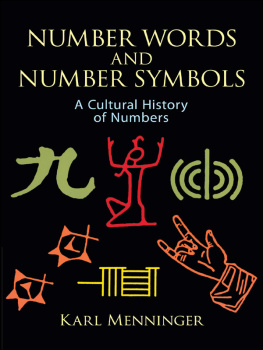

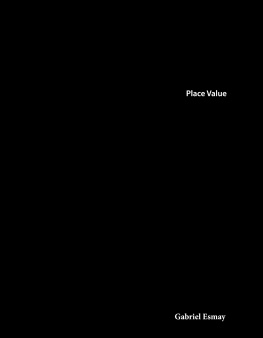


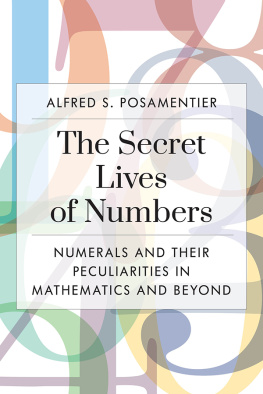
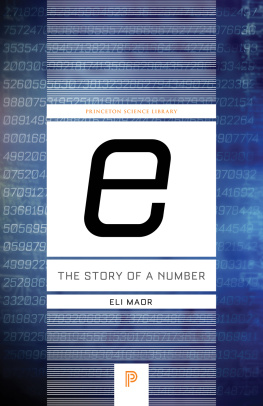
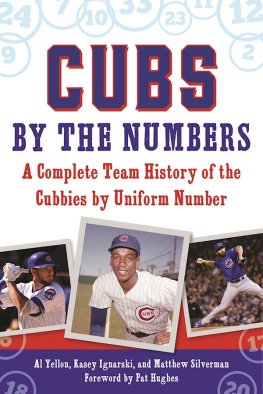
![Kasittik [Kasittik] - Origami Number & Symbols: Paper Folding The Number 0 - 9 & Symbols.: Paper Folding The Number 0 - 9 & Symbols.](/uploads/posts/book/144051/thumbs/kasittik-kasittik-origami-number-symbols.jpg)
